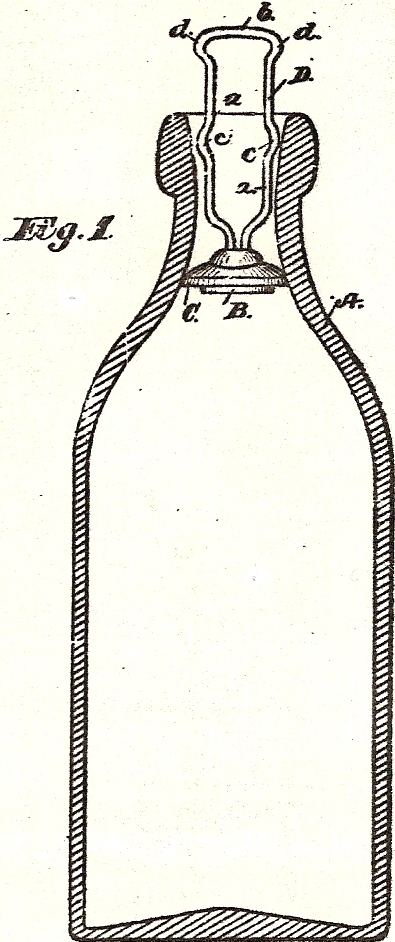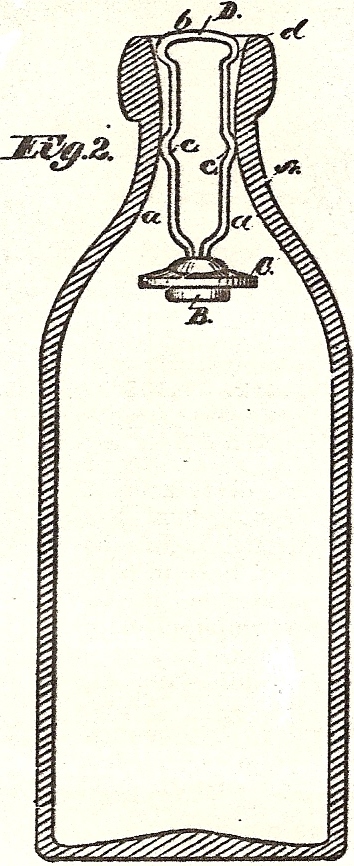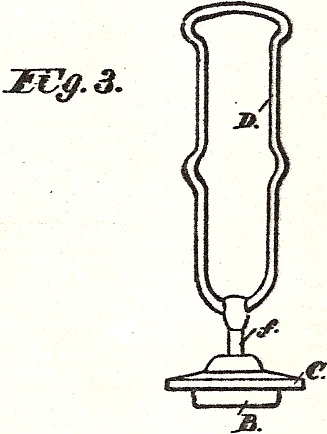John Klee Bottle Stopper



John Klee’s patent application
was filed October 13, 1879 and specified:
I, John Klee, of Dayton…Ohio, have invented certain
new and useful Improvements…(relating)…to an improvement in
bottle-stoppers of that class which are suspended within the neck or
throat of the bottle, and which are held in place by being drawn up into
said neck and by the expansive force of the contents.
The novelty of my invention consists in the
combination, with an internal bottle-stopper, of the grasping-loop made
of a continuous piece of wire with rigidly-fastened ends and provided
with lateral curves or shoulders near its upper end…
In the accompanying drawings, Figure 1 is a section
view of a bottle in elevation, showing the application of my improved
stopper drawn up to close the bottle.
Fig. 2 is a corresponding view with the stopper pushed in.
Fig. 3 is a modification in the construction of the stopper.
A. represents the
bottle, of any suitable construction.
B. is the head-piece or
plug, of metal, either in two parts, to clamp the rubber disk
C. between them, or made solid
with a circumferential groove, into which the eye in the disk fits by
being drawn over the upper smaller portion of the head.
D. represents the
spring guide-stem and grasping-loop, made of comparatively light
wire…bent to form two nearly parallel stems,
a, united at their upper ends by the portion
b, and bent in at their lower ends and secured in any suitable
manner to plug B…
The stems a
are bent outward about halfway of their length to form the curved
shoulders c, and the upper portion, b,
is projected beyond the line of the stems by similar shoulders
d.
The distance apart of the stems
a is such that when inserted
in the neck of the bottle the shoulders
c bind slightly against the
neck, and thus prevent the loop from rattling, and at the same time when
the stopper is forced down, as in Fig. 2, so as to open the bottle, the
stopper is held from returning or slipping back as the bottle is
inverted.
Instead of having the lower ends of the loop enter the
head B, they may be connected by solder to a short stem,
f, Fig. 3, which stem is
riveted or screwed into the head.
I am aware that spring grasping-loops have been
employed in connection with suspended stoppers, as shown in…patents
to…C. G. Hutchinson, and…J. B. Miller; but in both these cases the
spring-loops had one or both ends free, and required heavier wire to
render them effective. My loop,
on the contrary, has its ends rigidly fastened, thus producing a much
more efficient spring and enabling me to use lighter wire.
Comments:
Numerous variants of bottles
utilized by John Klee have been found in the
In spite of the obvious similarity to Charles G.
Hutchinson’s earlier patent, the U.S. Patent Office apparently approved
John Klee’s patent application because of his “improvements.”
125+ years later it appears Klee may have tweaked
 HutchBook.com
HutchBook.com